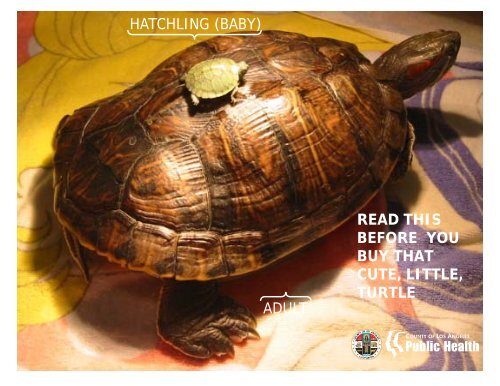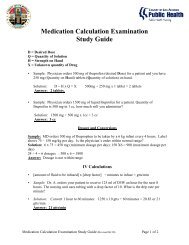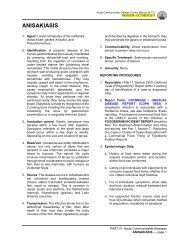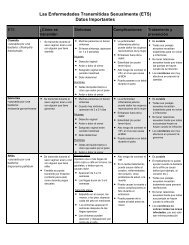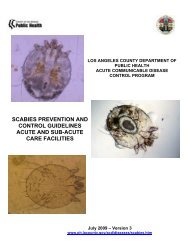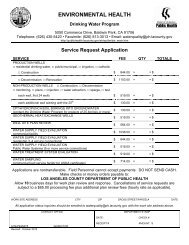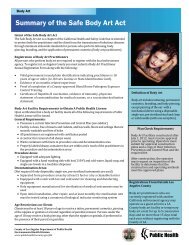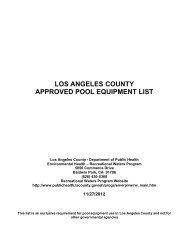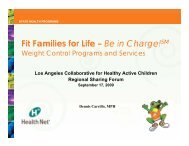read this before you buy that cute, little, turtle - Department of Public ...
read this before you buy that cute, little, turtle - Department of Public ...
read this before you buy that cute, little, turtle - Department of Public ...
Create successful ePaper yourself
Turn your PDF publications into a flip-book with our unique Google optimized e-Paper software.
HATCHLING (BABY)<br />
ADULT<br />
READ THIS<br />
BEFORE YOU<br />
BUY THAT<br />
CUTE, LITTLE,<br />
TURTLE
IT’S A TURTLE—NOT A TOY!<br />
You <strong>buy</strong> a <strong>little</strong> green <strong>turtle</strong> with red jellybean<br />
patches behind its eyes, a <strong>cute</strong> “plastic lagoon”<br />
bowl with a <strong>little</strong> palm tree, and a <strong>little</strong> “<strong>turtle</strong><br />
food” in a box or bag.<br />
Maybe <strong>you</strong> are “told” <strong>that</strong> the <strong>turtle</strong> will grow to fit<br />
the bowl and live its life there; maybe <strong>that</strong> is what<br />
<strong>you</strong> think—after all, the <strong>turtle</strong> is so small. It is so<br />
<strong>cute</strong>. So trouble-free. An ideal pet for <strong>you</strong>, <strong>you</strong>r<br />
child, <strong>you</strong>r family? Red-eared sliders can live up<br />
to thirty years. Only individuals willing to commit<br />
time, energy and money should consider a <strong>turtle</strong><br />
for a pet.<br />
The <strong>cute</strong> plastic “lagoon” bowl with the <strong>little</strong> palm<br />
tree is to the hatchling what a car seat is to a<br />
human infant—a temporary carrier. That hatchling<br />
<strong>you</strong> brought home needs an absolute minimum <strong>of</strong><br />
a ten gallon tank. An adult red-slider <strong>turtle</strong> (shown<br />
above) requires a minimum 75 gallon tank to a<br />
“more comfortable” 125 gallon tank.<br />
Further, to ensure a healthy <strong>turtle</strong> <strong>of</strong> any age or<br />
size, it is vital to keep its tank at about 80°F in<br />
order for <strong>you</strong>r pet to maintain basic life functions.<br />
Other basic-life-equipment include a submersible<br />
aquarium heater with a thermostat, a basking light,<br />
a good filter and the right commercial <strong>turtle</strong> food<br />
(specific to red-eared sliders). Too, “escape-pro<strong>of</strong>”<br />
the top <strong>of</strong> the tank as red-eared sliders are good<br />
climbers, and can escape from their tanks.<br />
013108<br />
ENVIRONMENTAL DAMAGE<br />
OF RED-EARED SLIDER TURTLES<br />
For the first time since 1975, it may become legal to<br />
sell or <strong>buy</strong> any live <strong>turtle</strong>(s) with a carapace [upper<br />
shell] length <strong>of</strong> less than 4 inches. Turtle farmers<br />
have developed ways to ensure <strong>that</strong> these baby<br />
reptiles are salmonella free at the time <strong>of</strong> sale.<br />
The proposed amendment does not address the<br />
difficulty <strong>of</strong> keeping these reptiles samonella free.<br />
Nor does it recall the reasons for the ban <strong>of</strong> the sale<br />
<strong>of</strong> baby <strong>turtle</strong>s 31 years ago: too many <strong>you</strong>ng<br />
children who played with these pet <strong>turtle</strong>s were<br />
getting sick from Salmonella, the germ <strong>that</strong> causes<br />
salmonellosis. Infants, children, and older adults<br />
continue to die from<br />
<strong>this</strong> disease.<br />
Red-eared slider <strong>turtle</strong>s<br />
are reptiles. They carry<br />
Salmonella, as well as<br />
other germs and tiny<br />
bugs. They can infect native wild <strong>turtle</strong>s when these<br />
pets are “humanely released” into city park ponds,<br />
streams and rivers and other water ways.<br />
Red-eared slider <strong>turtle</strong>s are aggressive creatures<br />
which multiply rapidly. Red-eared sliders have<br />
no known “enemies” in the wild. Given the chance,<br />
red-eared sliders will replace native <strong>turtle</strong>s<br />
and other local wildlife, and cause serious<br />
environmental harm.<br />
If <strong>you</strong> have a red-eared slider <strong>turtle</strong> (or any other<br />
no-longer-wanted pet), there are numerous pet<br />
rescue associations in Los Angeles County who will<br />
find homes or shelters for them. These non-pr<strong>of</strong>it<br />
rescue groups can be found on the Internet. For<br />
<strong>turtle</strong>s, enter the key words “<strong>turtle</strong> rescue”. Look for<br />
postings at local pet stores. Ask about them at <strong>you</strong>r<br />
community library. Just don’t dump <strong>you</strong>r pet!<br />
Special Thanks! to our Partners in <strong>Public</strong> Health<br />
at Austins Turtle Page (ATP) for allowing us to<br />
reproduce selected photographs and information<br />
from their web pages at www.austins<strong>turtle</strong>page.com/.<br />
SALMONELLOSIS (caused by Salmonella)<br />
All reptiles, including <strong>turtle</strong>s, shed Salmonella, much<br />
like humans shed skin cells. Human skin cells are<br />
harmless; Salmonella bacteria and the salmonellosis<br />
disease <strong>that</strong> it causes, are not harmless. Indeed, it<br />
can be deadly.<br />
Across the United States, Salmonella causes an<br />
estimated 1.4 million cases <strong>of</strong> illness and 400 deaths<br />
each year. In Los Angeles County, 10% <strong>of</strong> all<br />
reported cases <strong>of</strong> salmonellosis involved persons who<br />
had direct or indirect contact with reptiles. Red-eared<br />
slider <strong>turtle</strong>s were the most common reptile in over<br />
50% <strong>of</strong> these cases.<br />
Contact with these baby <strong>turtle</strong>s and all other reptiles<br />
can be a very serious health risk to infants, small<br />
children, and adults with weakened immune systems.<br />
Symptoms <strong>of</strong> salmonellosis include nausea, vomiting,<br />
abdominal cramps, diarrhea, fever, and headache.<br />
Persons usually start feeling sick 12 to 36 hours after<br />
being exposed to a bacteria-shedding reptile, or any<br />
surfaces where its bacteria sp<strong>read</strong> to.<br />
Salmonellosis, the disease,<br />
usually lasts 2 to 7 days.<br />
Salmonella, the bacteria <strong>that</strong><br />
causes <strong>this</strong> disease, can<br />
survive on unwashed, dry<br />
surfaces for weeks. Clean all<br />
reptile-exposed surfaces with household disinfectant;<br />
wash all reptile-exposed materials—clothes, towels,<br />
and such—in hot water and detergent.<br />
If <strong>you</strong> are considering <strong>buy</strong>ing a baby <strong>turtle</strong>, or any<br />
other reptile, remember: no matter how clean <strong>you</strong><br />
keep <strong>you</strong>r pet, its housing, etc., it still sheds<br />
Salmonella. If <strong>you</strong> al<strong>read</strong>y own a <strong>turtle</strong> or any other<br />
reptile, wash its housing and dishes, etc., outside, or<br />
sanitize <strong>you</strong>r wash area. Most important, always<br />
wash <strong>you</strong>r hands thoroughly with soap and warm<br />
water after touching <strong>you</strong>r pet and their housing.<br />
For further information on salmonellosis, visit our<br />
web pages at www.publichealth.lacounty.gov/vet .


